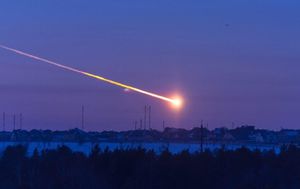
The Chelyabinsk meteor seems to be on par with what happened 100 years ago.
Tuvix72/YouTube
A century ago, on the eve before Thanksgiving, people across Michigan saw something that would mark Nov. 26 in their memories for years to come. Fog and rain rolled across the Great Lakes region, when just before 8 p.m. something unusual cut through the dark.
“The road, trees, houses and even ourselves were bathed in a blinding phosphorescent-like glow which had its center in a bright streak in the sky above us,” highway construction superintendent Leroy Milhan of Centerville, Michigan, would recall in a paper published the following year. “It passed over us toward the west. Immediately came a muffled report or jar that shook houses and the very earth like an earthquake.”
The following day, the Washington Times reported that “telegraph and telephone communications and electric lighting plants in several cities in southern Michigan and northern Indiana are out of commission” as a result of “a remarkable phenomenon believed by several scientists to have been a gigantic meteor.”
The newspaper describes a brilliant illumination resembling “an extraordinarily prolonged flash of heat lightning” in some cases accompanied by heavy thunder.
Property damage was reported in the communities of Battle Creek, Three Oaks and Athens, where “it is said, there was an earthquake, continuing for fully three minutes, accompanied by a heavy rain and wind storm, a loud clap of thunder and a flash of light in the sky of longer duration than lightning,” according to the newspaper.
It’s highly unlikely that a meteor actually triggered an earthquake amid the relative seismic calm of the Great Lakes region that evening. But the reports from a century ago, particularly those of numerous broken windows across the region are strikingly similar to what residents of Chelyabinsk, Russia, experienced in 2013, when a bolide exploded as it impacted our atmosphere over the region. The resulting shockwave shattered glass and reportedly felt an awful lot like an earthquake.
The lighthouse attendant at Grand Haven in 1919 told The New York Times: “What looked like a ball of fire appeared to fall in the lake about fifteen miles south of me. I thought it was a falling star. I could hear it whistle during its terrific rush toward the water. When it seemed to strike the water, a flash of flame shot in the air and caused a great disturbance. “
The fireball was often described as blue, turning to a mix of blue, red, green, white and yellow as it fragmented and the chunks raced toward the surface.
Another eyewitness account appears in the US Department of Agriculture’s weather bureau climatological data reports from the time:
“Newberry – A large and brilliant meteor was observed at about 8 pm of the 26th; it looked to be about 38 inches in diameter. It was first seen in the southwest — rather low but considerably above the horizon — with its course southeastward and downward. At a point about 9 degrees west west of south and near the horizon it appeared to be bursting like a rocket as it sank from view.”
The Chelyabinsk meteor was the most powerful such impact in recent decades, and while comparable data doesn’t exist for the 1919 event, the eyewitness accounts make it seem to be on par with what happened in Russia early in this decade.
One Grand Rapids Press headline took a semi-mocking approach to the incident that would have fit well in our Twitter feeds today: “Meteor fell in lake or there was a quake, aurora went on spree or — somethin’ happened.”
In both cases, no one seemed to actually see the meteor strike the surface at close range, but it does seem to have ended up in a lake or nearby.
Astronomers now spot new asteroids pretty much every day, and the odds of getting hit by rocks or debris from space are infinitesimally small. It’s also worth noting that we have added several thousand potential impactors to orbit in the form of satellites and other old spacecraft since the dawn of the space age, so it’s at least a tiny bit more likely to happen today than in 1919. With that in mind, enjoy whatever holidays you might be celebrating soon, but keep your eyes up as much as possible!







